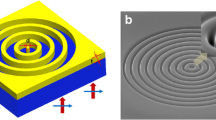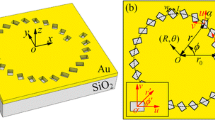Abstract
A 1D plasmonic zone plate lens (PZPL) consisting of nano-slits within a metal film introduces a phase delay distribution across the planar device surface by a modulation of the slit widths and positions to achieve light focusing. Using the finite-difference time-domain method, the number of zones is found to be a crucial factor for a well-controlled focal length, i.e. at least three zones are necessary for a PZPL exhibiting a focal length in agreement with the design. This conclusion is confirmed by confocal scanning optical microscopy on PZPLs patterned in an aluminium film. In addition, subwavelength light focusing is demonstrated both theoretically and experimentally in a PZPL. A larger PZPL, i.e. more zones, shows a higher resolution. A full full-width half-maximum of 0.37λ in the focal plane is shown theoretically in a PZPL with seven zones. A comparison between the PZPL and the plasmonic Fresnel zone plate shows that PZPLs have a higher contrast at the focus.









Similar content being viewed by others
References
Lezec HJ, Degiron A, Devaux E, Linke RA, Martin-Moreno L, Garcia-Vidal FJ, Ebbesen TW (2002) Science 297:820–822
Sun Z, Kim HK (2004) Appl Phys Lett 85:642–644
Shi H, Wang C, Du C, Luo X, Dong X, Gao H (2005) Opt. Express 13:6815–6820
Sun Z (2006) Appl Phys Lett 89:261119
Fu Y, Zhou W, Lim LEN, Du CL, Luo XG (2007) Appl Phys Lett 91:061124
Fu Y, Du C, Zhou W, Lim L (2008) Research Letter in Physics 2008:148505
Chen Y, Zhou C, Luo X, Du C (2008) Opt Lett 33:753–755
Xu T, Wang C, Du C, Luo X (2008) Opt Express 16:4753–4759
Mote RG, Yu SF, Ng BK, Zhou W, Lau SP (2008) Opt Express 16:9554–9564
Verslegers L, Catrysse PB, Yu Z, White JS, Barnard ES, Brongersma ML, Fan S (2009) Nano Lett 9:235–238
Jung YJ, Park D, Koo S, Yu S, Park N (2009) Opt Express 17:18852–18857
Verslegers L, Catrysse PB, Yu Z, Shin W, Ruan Z, Fan S (2010) Opt Lett 35:844–846
Lin L, Goh XM, McGuinness LP, Roberts A (2010) Nano Lett 10:1936–1940
Fu Y, Liu Y, Zhou X, Xu Z, Fang F (2010) Opt Express 18:3438–3443
Goh XM, Lin L, Roberts A (2010) Opt Express 18:11683–11688
Wang J, Zhou W (2010) Plasmonics 5. doi:10.1007/s11468-010-9147-6
Chen Q, Cumming DRS (2010) Opt Express 18:14788–14793
Lee B, Kim S, Kim H, Lim Y (2010) Prog Quantum Electron 34:47–87
Fu Y, Zhou X (2010) Plasmonics 5:287–310
Ruffieux P, Scharf T, Herzig HP, Völkel R, Weoble KJ (2006) Opt Express 14:4687–4694
Gordon R, Brolo AG (2005) Opt Express 13:1933–1938
Lumerical FDTD solution. http://www.lumerical.com/
Stigliani D, Mittra R, Semonin R (1967) J Opt Soc Am 57:610–613
Ebbesen TW, Lezec HJ, Ghaemi HF, Thio T, Wolff PA (1998) Nature 391:667–669
Acknowledgement
The author appreciates the help of Dr. Tomas Dieing and Dr. Elena Bailo from WITech GmbH for their support with confocal scanning optical microscopy. He also thanks Prof. David Cumming for his useful suggestion. This project is funded by a grant from the UK EPSRC.
Author information
Authors and Affiliations
Corresponding author
Rights and permissions
About this article
Cite this article
Chen, Q. Effect of the Number of Zones in a One-Dimensional Plasmonic Zone Plate Lens: Simulation and Experiment. Plasmonics 6, 75–82 (2011). https://doi.org/10.1007/s11468-010-9171-6
Received:
Accepted:
Published:
Issue Date:
DOI: https://doi.org/10.1007/s11468-010-9171-6




